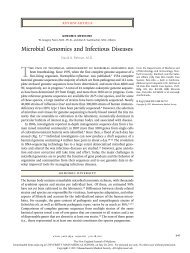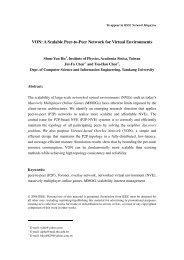366.7 KB - Evernote
366.7 KB - Evernote
366.7 KB - Evernote
You also want an ePaper? Increase the reach of your titles
YUMPU automatically turns print PDFs into web optimized ePapers that Google loves.
Otherwise, sets _KTHREAD.ApcState.KernelApcPending = 1 and requests an APC interrupt, which<br />
will call nt!KiDeliverApc when the IRQL drops below APC. We will add a few more detail about this<br />
interrupt in a short while.<br />
Hence, at least in the functions I observed (nt!NtQueryInformationFile, nt!KeLeaveGuardedRegion,<br />
nt!IopParseDevice), kernel APCs are serviced as soon as SpecialApcDisable is zeroed, if the IRQL<br />
allows it.<br />
The APC Interrupt<br />
Now let’s get back to nt!KiInsertQueueApc. We just analyzed what happens if<br />
_KTHREAD.SpecialApcDisable is not 0; if, on the other hand, it is 0, the function requests an APC<br />
software interrupt by calling hal!HalRequestSoftwareInterrupt, then quits.<br />
Before exploring the effect of this interrupt, let’s note that the actions performed by<br />
nt!KiInsertQueueApc when the APC is for the current thread, are the same, both for regular and<br />
special kernel mode APCs. Hence, the restrictions on regular APCs, which are dispatched only when<br />
certain conditions apply, are implemented into nt!KiDeliverApc, as we will see later.<br />
The APC interrupt can’t be processed right now, because inside nt!KiInsertQueueApc the IRQL is at<br />
0x1b, but will eventually click when the IRQL is lowered inside nt!KeInsertQueueApc. When this<br />
happens, nt!KiDeliverApc is called.<br />
This leads us to an interesting question. In the time between the interrupt request and its servicing,<br />
the timer keeps interrupting the processor, given that its IRQL is 0x1c, higher than the current one.<br />
The handler for this interrupt could detect that the quantum for the current thread has expired and<br />
request a DPC software interrupt to invoke the thread dispatcher.<br />
In this scenario, when the IRQL is lowered to PASSIVE, there are two outstanding software interrupts:<br />
the DPC and the APC one, with the former having a higher IRQL and therefore taking priority.<br />
Thus, the dispatcher is invoked, which may select a different thread to run. Eventually, the IRQL will<br />
drop to PASSIVE and the APC interrupt will click, in the context of the wrong thread. However, two<br />
steps in the overall APC logic save the day.<br />
The first one is the APC dispatcher, nt!KiDeliverApc, which is ultimately invoked by the APC interrupt,<br />
and allows for the case of being called and finding that there are no APCs in the list. If this happens, it<br />
just returns. Thus, when invoked for the wrong thread it’s harmless.<br />
Still, we may think we are at risk of “loosing” the APC for the right thread, given that the interrupt is<br />
now gone. This is not the case, because the KernelApcPending flag is still set and nt!SwapContext<br />
will look at it when the original thread will get its chance to run again, re-triggering a call to<br />
nt!KiDeliverApc.<br />
Can The APC Interrupt Really Break into The Wrong Thread?<br />
The test driver for this article, for which more details can be found in the appendix, shows how the<br />
scenario of the previous section can actually happen. The test function for this test is<br />
ApcSpuriousIntTest.<br />
This function installs hooks at the beginning of nt!SwapContext and nt!KiDeliverApc, which track when<br />
these functions are called, along with some data at the time of the call. Then it raises the IRQL to<br />
DISPATCH, schedules the APC and wastes time waiting for the DISPATCH interrupt to be requested.<br />
Afterwards, it lowers the IRQL to passive, having both the APC and DPC interrupts outstanding. The<br />
driver writes to the debugger console a trace of what happens.<br />
11
















